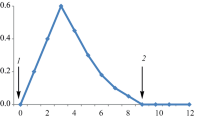Summary
Phosphofructokinase (PFK) from swine kidney was purified by a procedure which included affinity chromatography on Cibacron blue F3GA-Sepharose 4B and ATP-Sepharose 413 columns in order to examine its binding properties. The homogeneous enzyme was purified more than 3 000-fold with a yield of 30% and it had a specific activity of 39.8 µmol/min/ mg of protein at 25°C. The molecular weight of the native enzyme was 360 000 and it contained 4 identical subunits of molecular weight 88 000. The principal catalytically reacting form of the enzyme had a S20,w of 13.7 S which corresponds to a molecular weight of 360 000 ± 6 000. The initial velocity patterns in the forward and reverse directions suggested a sequential mechanism for the reaction. The Km values for fructose 6-phosphate, ATP, fructose, 1,6-bisP and ADP were 33 µM, 8.3 µM, 460 µM, and 110 µM, respectively.
The homogeneous native enzyme binds specifically to phosphoryl groups immobilized in cellulose phosphate columns. ATP and fructose 6-phosphate interacted with the enzyme and decreased its affinity for phosphoryl binding sites. Other metabolites including fructose 1,6-bisP, glucose 6-phosphate and various nucleotides, alone or in various combinations, were ineffective in promoting the dissociation of the enzyme. Allosteric effectors of the enzyme, such as citrate and AMP were also inactive. However, they cooperatively altered the eoncentration of ATP required to dissociate the enzyme from phosphoryl groups. The bound enzyme was enzymatically inactive. The enzyme was also inactivated when it was treated with pyridoxal 5′-phosphate and reduced with sodium borohydride and the inactive enzyme no longer bound to cellulose phosphate. These effects were not observed when treatment with pyridoxal 5′-phosphate was carried out in the presence of fructose 6-phosphate.
These observations and the results of similar studies with swine kidney fructose 1,6-bisphosphatase (FBPase) show that both enzymes share the unique property of binding specifically to phosphoryl groups. FBPase interacts through its allosteric AMP binding site and PFK binds through its fructose 6-P binding site. This specific binding of both enzymes through these sites result in the inactivation of PFK and the desensitization of FBPase to allosteric inhibition by AMP. In the unbound state PFK may be active and FBPase can be inhibited by AMP. Taken collectively, these binding effects could play a role in the reciprocal regulation of these enzymes during gluconeogenesis in kidney.
Similar content being viewed by others
References
Mansour, T. E., 1972. Curr. Top. Cell. Regul. 5: 1–46.
Bloxham, D. P. and Lardy, H. A., 1973. In: The Enzymes (Boyer, P. D., ed.), Vol. 8, pp. 239–278, Academic Press, New York.
Uyeda, K., 1979. Adv. Enzymol. Relat. Areas Mol. Biol. 48: 193–228.
Furuya, E. and Uyeda, K., 1980. Proc. Natl. Acad. Sci. U.S.A. 77:5861–5864.
Van Schaftingen, E., Hue, L. and Hers, H. G., 1980. Biochem. J. 192: 897–901.
Uyeda, K., Furuya, E. and Luby, L. J., 1981. J. Biol. Chem. 256:8394–8399.
Van Schaftingen, E. and Hers, H. G., 1981. Proc. Natl. Acad. Sci. U.S.A. 78: 2861–2863.
Masters, C. J., 1981. CRC Crit. Rev. Biochem. 11: 105–143.
Karadsheh, N. S. and Uyeda, K., 1977. J. Biol. Chem. 252: 7418–7420.
Highashi, T., Richards, C. S. and Uyeda, K., 1979. J. Biol. Chem. 254: 9542–9550.
Arnold, H. and Pette, D., 1970. Eur. J. Biochem. 15: 360–366.
Clarke, F. M. and Masters, C. J., 1975. Biochim. Biophys. Acta 381: 37–41.
Kratowich, N. and Mendicino, J., 1974. J. Biol. Chem. 249: 5485–5494.
Allen, M. B. and Blair, J. M., 1972. Biochem. J. 130: 1167–1169.
Mendicino, J., Abou-Issa, H., Medicu, R. and Kratowich, N., 1975. In: Methods Enzymol., Vol. 42, pp. 375–397. Academic Press, New York.
Schachman, H. K., 1959. In: Ultracentrifugation in Biochemistry, Academic Press, New York.
Mendicino, J., Kratowich, N. and Oliver, R. M., 1972. J. Biol. Chem. 241: 6643–6650.
Cohen, R., Girand, B. and Messiah, A., 1967. Biopolymers 5: 203–225.
Taylor, B. L., Barden, R. E. and Utter, M. F., 1972. J. Biol. Chem. 247: 7383–7390.
Abou-Issa, H. and Mendicino, J., 1973. J. Biol. Chem. 248: 685–696.
Travis, J. and Pannell, R., 1973. Clin. Chim. Acta 49: 49–53.
Ramadoss, C. S., Luby, L. J. and Uyeda, K., 1976. Arch. Biochem. Biophys. 175: 487–494.
Cleland, W. W., 1963. Nature 198: 463–466.
Cleland, W. W., 1967. Ann. Rev. Biochem. 36: 77–112.
Lowry, O. H., Rosebrough, N. J., Farr, A. L. and Randall, R. J., 1951. J. Biol. Chem. 193: 265–273.
Hanna, R. and Mendicino, J., 1970. J. Biol. Chem. 245: 4031–4037.
Uyeda, K., 1969. Biochemistry 8: 2366–2373.
Setlow, B. and Mansour, T. E., 1972. Biochim. Biophys. Acta 258: 106–112.
Mendicino, J. and Vasarhely, F., 1963. J. Biol. Chem. 240: 3528–3536.
Bohme, H. -J., Kopperschlager, G., Schultz, J. and Hofmann, E., 1972. J. Chromatogr. 69: 209–215.
Stellwagen, E., Cass, R., Thompson, S. T. and Woody, M., 1975. Nature 257: 716–718.
Massey, T. H. and Deal, W. C., Jr., 1973. J. Biol. Chem. 248: 56–62.
Uyeda, K., 1970. J. Biol. Chem. 245: 2268–2275.
Vinnela, E., Salas, M. L. and Sols, A., 1963. Biochem. Biophys. Res. Commun. 12: 140–144.
Layzer, R. B., Rowland, L. P. and Bank, W. J., 1969. J. Biol. Chem. 244: 3823–3831.
Hanson, R. L., Rudolph, F. B. and Lardy, H. A., 1973. J. Biol. Chem. 248: 7852–7859.
Lowry, O. H. and Passonneau, J. V., 1966. J. Biol. Chem. 241:2268–2275.
Brand, I. A. and Soling, H., 1974. J. Biol. Chem. 249: 7824–7831.
Kee, A. and Griffin, C. C., 1972. Arch. Biochem. Biophys. 149: 361–367.
Faupel, R. P., Seitz, H. J., Tarnowski, W., Thiermann, V. and Weiss, C., 1972. Arch. Biochem. Biophys. 148: 509–522.
Mendicino, J., Leibach, F. H. and Reddy, S., 1978. Biochemistry 17: 4662–4668.
Author information
Authors and Affiliations
Rights and permissions
About this article
Cite this article
Ashkar, S., Muniyappa, K., Leibach, F. et al. Evidence for a specific phosphoryl binding site in swine kidney phosphofructokinase. Mol Cell Biochem 62, 77–92 (1984). https://doi.org/10.1007/BF00230080
Received:
Issue Date:
DOI: https://doi.org/10.1007/BF00230080




